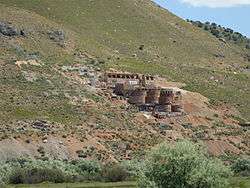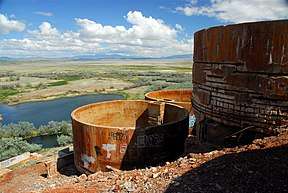Tintic Standard Reduction Mill
The Tintic Standard Reduction Mill—also known as the Tintic Mill or Harold Mill—built in 1920, and only operating from 1921 to 1925, is an abandoned refinery or concentrator located on the west slope of Warm Springs Mountain on the southern edge of Genola, Utah, United States.
Tintic Standard Reduction Mill | |
 Tintic Standard Reduction Mill, June 2009 | |
  | |
| Nearest city | Genola, Utah United States |
|---|---|
| Coordinates | 39.95748°N 111.85500°W |
| Area | 0.1 acres (0.040 ha) |
| Built | 1916 |
| Built by | Madge, W.C. |
| NRHP reference No. | 78002700[1] |
| Added to NRHP | September 13, 1978 |
Description

The mill was designed and built by W. C. Madge. It is significant as the only American mill using the Augustin process during the early 1920s.[2] Metals processed at the mill included copper, gold, silver, and lead, all of which were received from another mill near Eureka. The metal content of ore was increased through the process to make transportation less expensive. The reducing process used was an acid-brine chloridizing and leaching process which became outdated, leading to the abandonment of the site in 1925. At the mill's highest productivity it processed 200 tons of ore daily from the Tintic Mining District.
What remains of the mill are foundations for water tanks, crushers, roasters, iron boxes, leaching tanks, and drain boxes. The site dominates the surrounding landscape with its size and unique colors and shapes. It has been speculated that the mill may be the contributor of heavy metal pollution in the Warm Springs which lie below it.
It was listed on the National Register of Historic Places in 1978.[1]
See also
- Tintic Smelter Site, site of a different "Tintic Mill", near Eureka in Juab County, Utah
- National Register of Historic Places listings in Utah County, Utah
References
- "National Register Information System". National Register of Historic Places. National Park Service. July 9, 2010.
- Philip F. Notarianni (January 30, 1978). "National Register of Historic Places Inventory/Nomination: Tintic Standard Reduction Mill". National Park Service. and accompanying two photos from 1977
- Warm-Water Interim Hatchery Facility - Environmental Assessment. Utah Reclamation Mitigation Conservation Commission.
- National Register of Historic Places
External links
| Wikimedia Commons has media related to Tintic Standard Reduction Mill. |
- The Center for Land Use Interpretation - Includes a photo of the site.
- Historic American Engineering Record (HAER) No. UT-12, "Tintic Standard Reduction Mill, Warm Springs Mountain, Goshen, Utah County, UT", 13 photos, 4 measured drawings, 6 data pages, 1 photo caption page
- - An early photo of the Mill from the Utah State Historical Society.